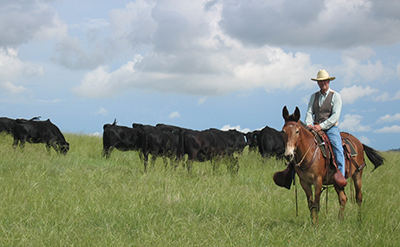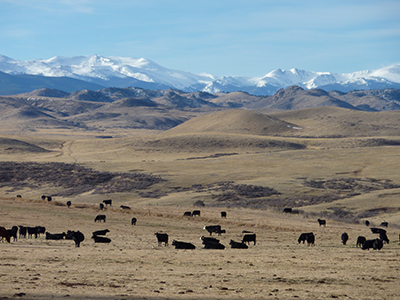The Laramie Foothills Group - Conservation at the Scale of a Watershed
By:
Richard L. Knight
"When asked if I am pessimistic or optimistic about the future, my answer
is always the same: If you look at the science that describes what is
happening on Earth and aren’t pessimistic, you don’t have the data. Yet,
if you meet the people in this unnamed movement and aren’t optimistic,
you haven’t got a heart." Paul Hawken (2007)
In northern Colorado, sitting at one end of a 160-mile-long swath of runaway sprawl, the future looks quite different today than it did a decade earlier. Until the 1990s, northern Colorado was heading in the same direction as the rest of Colorado’s Front Range. At the peak of land conversion, Colorado was losing the size of Rocky Mountain National Park in farm and ranch land every year. That is, we were swapping farm and forest land for exurbs stretching as far as the eye could see and the mind could fathom.
Northern Colorado had a different vision. Its residents refused to believe that its watershed was like any other place, to be treated as just another piece of real estate, where developers and elected officials conspired to turn once-productive working lands into deficit-spiraling urbs, whether exurb or suburb.
Organizing around the Laramie Foothills Group, with city and county residents passing sales taxes to help conserve open spaces, a remarkable coalition of rural and urban constituencies coalesced to ensure that land beyond city limits stayed open and productive, rather than developed and running red deficits on county and city ledgers.
Beginning slow, taking baby steps in order to go fast, there were years of gatherings, meetings on the land, in private homes and city buildings, over coffee, and over beer. Asking questions, crossing political ideologies to focus on what brought us together, people began to see commonalities rather than differences. Everyone wanted to live in a prosperous watershed, where both the land and the human communities did well, where producers and consumers of food could meet locally, where open space, whether private or public, was conserved rather than developed. Some worried that it was already too late, that we had squandered what an American writer saw when she penned these words atop Pikes Peak looking out over the Colorado Front Range:
“O beautiful for spacious skies,
For amber waves of grain,
For purple mountain majesties
Above the fruited plain!
America! America!
God shed his grace on thee”
Katharine Lee Bates, a young English professor at Wellesley College, gazing out over the Colorado Front Range was bewitched by the beauty of what she saw as well as by a swelling patriotism and love of country. Over a century later, it was the beauty of working wildlands in a still largely intact watershed that compelled people in northern Colorado to come together and find a middle way.

Little by little progress was made, a ranch conserved here, an agricultural working group formed there, an invasive-weed cooperative started, a place-based education program organized in the rural schools, city and county open space programs working together, ranch families beginning to see that their urban cousins genuinely cared about ranchers’ livelihoods, localvores in towns who wanted to know where their food came from and were tired of subsidizing developers. The time seemed ripe for a unifying event. It happened in 2003.
Due to several large ranches being placed on the market or their owners seeing the wisdom of placing conservation easements on their land, and some risk-prone individuals working for city and county governments, a progressive land trust, and an international conservation organization, forces converged to protect an east-west swath of land nearly 22 miles wide and 20 miles deep. Residents of Larimer County woke up one day and realized that the northern part of the Colorado Front Range would never be the same again. The future that spread out before its residents now held intact the promise of rural and urban communities coming together over locally produced food on locally conserved open spaces.
Someone else awoke that morning with what must have been a surprise. For the forest supervisor of the Roosevelt National Forest looked east to his Pawnee National Grasslands and west to his Canyon-Lakes District and realized that his forests and plains were now connected by an east-west swath of conserved land!
Updating this story of how people in a watershed took their destiny into their own hands serves as an introduction to a new way of doing conservation. For, truth be told, the U.S. Forest Service (USFS) was not involved in this immense conservation effort. Indeed, the only entity from the federal government that did play a vital role was the Natural Resources Conservation Service (NRCS). This agency has always worked with private landowners; its employees have learned that to be successful one must focus on listening and show due respect. There is little room for a top-down approach when working with private landowners who control approximately two-thirds of our country. The USFS, on the other hand, has traditionally taken a top-down, almost militaristic approach to managing its public land, an approach that doesn’t resonate well with Americans.
Today, watersheds across the country are increasingly self-organizing, with citizen-based groups coming together and finding ways to make where they live, work, play, and worship healthier, both conserving land and water but also strengthening economies (Knight and White 2009). Is this Balkanization of the U.S. a long-term trend? No one is sure, but one thing seems apparent: Watershed-based conservation is the approach that meets with the greatest buy-in and success, while the traditional federal and state approach of top-down control languishes.